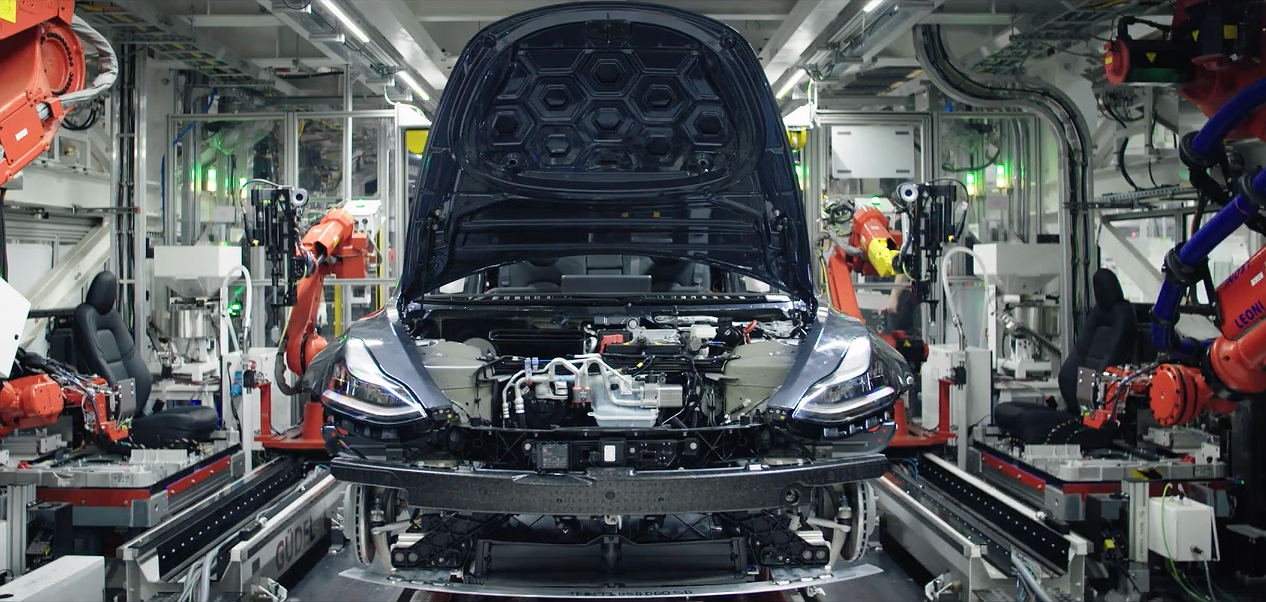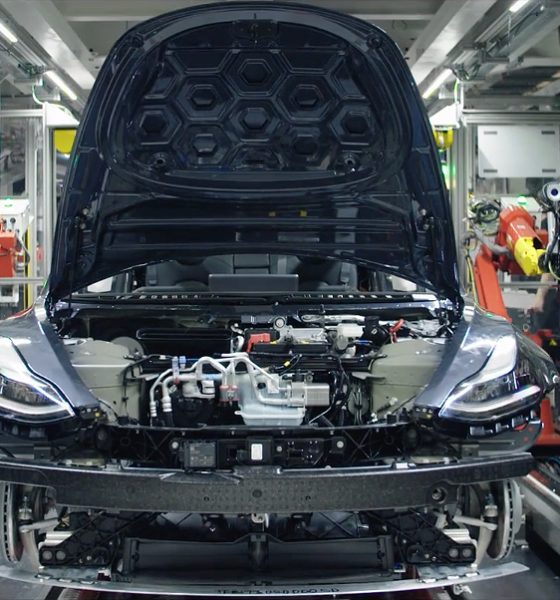

Investor's Corner
Tesla registers over 10,000 new Model 3 VINs as Dual Motor production ramp continues
Tesla has registered two large batches totaling more than 10,000 new Model 3 VINs over the weekend, in what appears to be a sign of a renewed production push for the electric sedan. Both batches, the first being 2,625 registrations and the other being 7,903, are estimated to be comprised of dual motor AWD vehicles.
#Tesla registered 7,903 new #Model3 VINs. ~100% estimated to be dual motor. Highest VIN is 89107. https://t.co/OZqpp8nPjs
— Model 3 VINs (@Model3VINs) August 5, 2018
#Tesla registered 2,625 new #Model3 VINs. ~88% estimated to be dual motor. Highest VIN is 81204. https://t.co/SVarfCqPe5
— Model 3 VINs (@Model3VINs) August 4, 2018
With the addition of this weekend’s 10,528 new Model 3 filings, Tesla has now registered a total of 89,107 vehicles since the electric car started production last year. These latest filings are among Tesla’s most significant yet, considering that the company’s VIN registrations only went past the 10,000-mark near the end of January, roughly six months into the electric car’s production.
During Tesla’s Q2 2018 earnings call, CEO Elon Musk stated that Tesla was able to maintain the Model 3’s 5,000/week production rate across multiple weeks in July. Musk’s statement about the Model 3’s production falls in line with the trend displayed by VIN registrations during the first two weeks of the month. Immediately after the beginning of Q3 2018, Tesla went on a VIN-filing spree, registering 19,000 new Model 3 VINs in the first half of July.
During the latter half of last month, however, Tesla’s VIN filings plateaued, with the company registering only a few vehicles at a time until this weekend. Quite interestingly, these last two big batches of VIN filings also corresponded to dual motor variants of the Model 3. Twitter watchdog group @Model3VINs initially estimated the first batch of 2,625 Model 3 VINs to include Long Range RWD variants of the electric car, but in the following update, the group noted that all the filings appeared to be dual motor.
Tesla has only started rolling out the dual motor AWD and Performance variants of the Model 3 recently. Nevertheless, Tesla worldwide head of sales Robin Ren stated during the second quarter earnings call that the dual motor AWD and Performance Model 3’s combined orders are now more than the orders for the vehicle’s Long Range RWD variant. The Tesla executive further noted that interest in the Model 3 remains high, with the company having 60,000 test drive requests for the electric sedan in the United States alone.
If Robin Ren’s statements and the recent Model 3 VIN filings are any indications, it appears that Tesla’s push to upsell the higher-end variants of the electric car to consumers is starting to pay off. Tesla, after all, stopped anti-selling the vehicle after the end of Q2 2018, offering test drives to customers and promoting the Model 3 Performance. In a Twitter post, Elon Musk also encouraged reservation holders to test drive the Model 3 Performance even if they do not have orders for the top-tier vehicle.
With its 5,000/week target for the Model 3’s production being met, Tesla is now aiming to sustain and increase its manufacturing capability for the electric car. During his opening remarks in the Q2 2018 earnings call, CEO Elon Musk stated that Tesla is aiming to produce 7,000 vehicles per week throughout Q3 2018. Musk also noted that Tesla is expecting its ramp to 10,000 Model 3 per week to involve only a “tiny fraction” of the CapEx used when it ramped the vehicle to 5,000 units per week.

Investor's Corner
Tesla stock closes at all-time high on heels of Robotaxi progress

Tesla stock (NASDAQ: TSLA) closed at an all-time high on Tuesday, jumping over 3 percent during the day and finishing at $489.88.
The price beats the previous record close, which was $479.86.
Shares have had a crazy year, dipping more than 40 percent from the start of the year. The stock then started to recover once again around late April, when its price started to climb back up from the low $200 level.
This week, Tesla started to climb toward its highest levels ever, as it was revealed on Sunday that the company was testing driverless Robotaxis in Austin. The spike in value pushed the company’s valuation to $1.63 trillion.
Tesla Robotaxi goes driverless as Musk confirms Safety Monitor removal testing
It is the seventh-most valuable company on the market currently, trailing Nvidia, Apple, Alphabet (Google), Microsoft, Amazon, and Meta.
Shares closed up $14.57 today, up over 3 percent.
The stock has gone through a lot this year, as previously mentioned. Shares tumbled in Q1 due to CEO Elon Musk’s involvement with the Department of Government Efficiency (DOGE), which pulled his attention away from his companies and left a major overhang on their valuations.
However, things started to rebound halfway through the year, and as the government started to phase out the $7,500 tax credit, demand spiked as consumers tried to take advantage of it.
Q3 deliveries were the highest in company history, and Tesla responded to the loss of the tax credit with the launch of the Model 3 and Model Y Standard.
Additionally, analysts have announced high expectations this week for the company on Wall Street as Robotaxi continues to be the focus. With autonomy within Tesla’s sights, things are moving in the direction of Robotaxi being a major catalyst for growth on the Street in the coming year.
Elon Musk
Tesla needs to come through on this one Robotaxi metric, analyst says
“We think the key focus from here will be how fast Tesla can scale driverless operations (including if Tesla’s approach to software/hardware allows it to scale significantly faster than competitors, as the company has argued), and on profitability.”

Tesla needs to come through on this one Robotaxi metric, Mark Delaney of Goldman Sachs says.
Tesla is in the process of rolling out its Robotaxi platform to areas outside of Austin and the California Bay Area. It has plans to launch in five additional cities, including Houston, Dallas, Miami, Las Vegas, and Phoenix.
However, the company’s expansion is not what the focus needs to be, according to Delaney. It’s the speed of deployment.
The analyst said:
“We think the key focus from here will be how fast Tesla can scale driverless operations (including if Tesla’s approach to software/hardware allows it to scale significantly faster than competitors, as the company has argued), and on profitability.”
Profitability will come as the Robotaxi fleet expands. Making that money will be dependent on when Tesla can initiate rides in more areas, giving more customers access to the program.
There are some additional things that the company needs to make happen ahead of the major Robotaxi expansion, one of those things is launching driverless rides in Austin, the first city in which it launched the program.
This week, Tesla started testing driverless Robotaxi rides in Austin, as two different Model Y units were spotted with no occupants, a huge step in the company’s plans for the ride-sharing platform.
Tesla Robotaxi goes driverless as Musk confirms Safety Monitor removal testing
CEO Elon Musk has been hoping to remove Safety Monitors from Robotaxis in Austin for several months, first mentioning the plan to have them out by the end of 2025 in September. He confirmed on Sunday that Tesla had officially removed vehicle occupants and started testing truly unsupervised rides.
Although Safety Monitors in Austin have been sitting in the passenger’s seat, they have still had the ability to override things in case of an emergency. After all, the ultimate goal was safety and avoiding any accidents or injuries.
Goldman Sachs reiterated its ‘Neutral’ rating and its $400 price target. Delaney said, “Tesla is making progress with its autonomous technology,” and recent developments make it evident that this is true.
Investor's Corner
Tesla gets bold Robotaxi prediction from Wall Street firm
Last week, Andrew Percoco took over Tesla analysis for Morgan Stanley from Adam Jonas, who covered the stock for years. Percoco seems to be less optimistic and bullish on Tesla shares, while still being fair and balanced in his analysis.

Tesla (NASDAQ: TSLA) received a bold Robotaxi prediction from Morgan Stanley, which anticipates a dramatic increase in the size of the company’s autonomous ride-hailing suite in the coming years.
Last week, Andrew Percoco took over Tesla analysis for Morgan Stanley from Adam Jonas, who covered the stock for years. Percoco seems to be less optimistic and bullish on Tesla shares, while still being fair and balanced in his analysis.
Percoco dug into the Robotaxi fleet and its expansion in the coming years in his latest note, released on Tuesday. The firm expects Tesla to increase the Robotaxi fleet size to 1,000 vehicles in 2026. However, that’s small-scale compared to what they expect from Tesla in a decade.
Tesla expands Robotaxi app access once again, this time on a global scale
By 2035, Morgan Stanley believes there will be one million Robotaxis on the road across multiple cities, a major jump and a considerable fleet size. We assume this means the fleet of vehicles Tesla will operate internally, and not including passenger-owned vehicles that could be added through software updates.
He also listed three specific catalysts that investors should pay attention to, as these will represent the company being on track to achieve its Robotaxi dreams:
- Opening Robotaxi to the public without a Safety Monitor. Timing is unclear, but it appears that Tesla is getting closer by the day.
- Improvement in safety metrics without the Safety Monitor. Tesla’s ability to improve its safety metrics as it scales miles driven without the Safety Monitor is imperative as it looks to scale in new states and cities in 2026.
- Cybercab start of production, targeted for April 2026. Tesla’s Cybercab is a purpose-built vehicle (no steering wheel or pedals, only two seats) that is expected to be produced through its state-of-the-art unboxed manufacturing process, offering further cost reductions and thus accelerating adoption over time.
Robotaxi stands to be one of Tesla’s most significant revenue contributors, especially as the company plans to continue expanding its ride-hailing service across the world in the coming years.
Its current deployment strategy is controlled and conservative to avoid any drastic and potentially program-ruining incidents.
So far, the program, which is active in Austin and the California Bay Area, has been widely successful.








